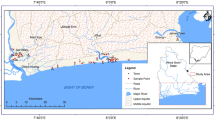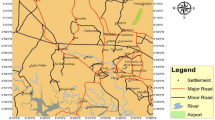Abstract
Management of groundwater resource is an essential key for the sustainable development of any particular area to be useful in different uses, especially in arid and semi-arid regions such as the Kingdom of Saudi Arabia (KSA). Al Marwani basin is an important water resource of Makkah Al-Mukarramah region, where groundwater is the primary source of water in all human activities. The main problem of this basin is that the majority of the groundwater wells have been randomly dug regardless of the hydrologic basics. This may lead to a noticeable decline in the groundwater level and increased water salinity. The aim of this research is to establish a roadmap for coastal aquifer management in Al Marawani basin based on the aquifer hydraulic parameters and groundwater chemical composition. Based on the data gathered from 76 drilled wells (2013 and 2021) including 14 long duration pum** tests, and 6 step-test, all hydrogeological parameters such as aquifer thickness, groundwater levels, transmissivity (T), hydraulic conductivity (K) and well efficiency γ were determined. The results of this study revealed that the aquifer thickness is 10–25 m, and a decline in water levels in some area within the basin. The estimated transmissivity (T) ranges from 0.000000296 to 425 m2/day with an average value of about 115.83 m2/day. The results of hydraulic conductivity (K) ranges from 0.000000028 to 25.3 m/day with an average value of about 7.589. The study aquifer is characterized by low to moderate potentiality. In the study area, 64 water samples were analyzed in 2021 and their salinities were compared with the measured salinity in 2013. The comparison revealed that the groundwater quality has deteriorated at some sites as indicated by the existence of high concentrations of TDS (more than 5000 mg/L). The relationships between the different ions showed that the effect of mineral weathering, leaching of saline soil residues, evaporation, human activity, and seawater intrusion are the main factors that govern the presence of ions and their relationships in groundwater. Chadha diagram revealed that Ca–Mg–Cl/SO4 and Na–Cl are the main groundwater types in the study basin. Gibbs diagram showed that the main mechanisms controlling the groundwater chemistry of the basin are evaporation and weathering of minerals in the rocks. According to the US Salinity Laboratory Staff for classification of the groundwater for irrigation, groundwater in most places in the Al Marawani basin (58%) can be classified as poor quality so only saline tolerant crops are preferred. This indicates that the coastal aquifer in the study basin has a declining water level and inclining salinity that is challenging for both domestic and irrigation uses, indicating that the water requires a proper management.













Similar content being viewed by others
Data availability statement
All data is provided as tables and figures in the manuscript.
References
Abderrahman WA, Rasheeduddin M, Al-Harazin IM, Esuflebbe M, Eqnaibi BS (1995) Impacts of management practices on groundwater conditions in the Eastern Province, Saudi Arabia. Hydrogeol J 3:32–41
Akhkha A, Salem AE, Al-Shoaibi AK (2019) The impact of treated and untreated municipal sewage water on growth and physiology of the desert plant Calotropis procera. J Taibah Univ Sci 13(1):746–754
Al-Ahmadi ME (2013) Hydrochemical characterization of groundwater in wadi Sayyah, Western Saudi Arabia. Appl Water Sci 3:721–732
Al-ahmadi ME, El-Fiky AA (2009) Hydrogeochemical evaluation of shallow alluvial aquifer of Wadi Marwani, western Saudi Arabia. J King Saud Univ (sci) 21:179–190
Ali I, Hasan MA, Alharbi OML (2020) Toxic metal ions contamination in the groundwater, Kingdom of Saudi Arabia. J Taibah Univ Sci 14:1571–1579
Al-Nujaidi HA (1978) Hydrogeology of Wadi Marwani–Khulais. M. Sc. thesis, Institute of Applied Geology, King Abdulaziz University, Jeddah, Kingdom of Saudi Arabia
Al-Omran AM, Aly AA, Al-Wabel MI, Sallam AS, Al-Shayaa MS (2016) Hydrochemical characterization of groundwater under agricultural land in arid environment: a case study of Al-Kharj, Saudi Arabia. Arab J Geosci 9:1–17
Alqarawy A, El Osta M, Masoud M, Elsayed S, Gad M (2022) Use of hyperspectral reflectance and water quality indices to assess groundwater quality for drinking in arid regions, Saudi Arabia. Water 14:2311. https://doi.org/10.3390/w14152311
Al-Shaibani AM (2008a) Hydrogeology and hydrochemistry of a shallow alluvial aquifer, western Saudi Arabia. Hydrogeol J 16:155–165
AlSuhaimi AO, AlMohaimidi KM, Momani KA (2019) Preliminary assessment for physicochemical quality parameters of groundwater in Oqdus Area, Saudi Arabia. J Saudi Soc Agric Sci 18:22–31
Brown GF (1960) Geomorphology of western and central Saudi Arabia. In: 21st International geological congress, Copenhagen, XXI, pp 150–155
Chadha DK (1998) A new diagram for geochemical classification of natural waters and interpretation of chemical data. Bhu-Jal 13(1 & 2):1–4
Crawford MD (1972) Hardness of drinking water and cardiovascular disease. Proc Natl Soc 31:347–353
Datta PS, Tayagi SK (1996) Major ion chemistry of groundwater in Delhi area: chemical weathering processes and groundwater flow regime. J Geol Soc India 47(2):179–188
Dawoud MA, Darwish MM, El-Kady MM (2005) GIS-based groundwater management model for Western Nile Delta. Water Resour Manag 19:585–604. https://doi.org/10.1007/s11269-005-5603-z
El-Osta MM (2006) Evaluation and management of groundwater in East El oweinat area, western desert, Egypt. Ph.D. thesis, Geology Department, Faculty of Science, Minufiya University
Gheorghe A (1979) Processing and synthesis of hydrogeological data. Abacus Press, Tunbridge Wells
Gibbs RJ (1970) Mechanism controlling world water chemistry. Science 17:1088–1090
Gilboy CF, Skiba W (1978) Geology of Khulays Quadrangle, Sheet 22/39c, Kingdom of Saudi Arabia. Saudi Arabian Dir, General Mineral and Resources Map, GM-34
Hantush MS (1964) Hydraulics of wells. In: Chow VT (ed) Advances in hydroscience. Academic Press, New York, pp 281–442
Islam S, Singh R, Abad Khan R, Danish M (2016) Analysis of potential evapotranspiration of different cities of Kingdom of Saudi Arabia. Int J Adv Innov Res 5(2):2278–7844
Jacob CE (1950) Flow of groundwater in engineering hydraulic. Wiley, New York, pp 321–386
The Kingdom of Saudi Arabia the Ministry of Water and Electricity (MOWE) (2010) The study on master plan on renewable water resource development in the Southwest Region in the Kingdom of Saudi Arabia. Final report, Japan International Cooperation Agency Yachiyo Engineering Co., Ltd. Sanyu Consultants Inc.
Karanth KR (1997) Groundwater assessment, development and management. Tata McGraw-Hill Publishers, New Delhi
Kruseman GP, de Ridder NA (1990) Analysis and evaluation of pum** test data, 2nd edn. International Institute for Land Reclamation and Improvement (ILRI), Dordrecht
Loni OA, Zaidi FK, Alhumimidi MS, Alharbi OA, Hussein MT, Dafalla M, AlYousef KA, Kassem OMK (2015) Evaluation of groundwater quality in an evaporation dominant arid environment; a case study from Al Asyah area in Saudi Arabia. Arab J Geosci 8:6237–6247
Mallick J, Singh CK, AlMesfer MK, Singh VP, Alsubih M (2021) Groundwater quality studies in the Kingdom of Saudi Arabia: prevalent research and management dimensions. Water 13:1266. https://doi.org/10.3390/w13091266
Masoud M, El Osta M, Alqarawy A, Elsayed S, Gad M (2022) Evaluation of groundwater quality for agricultural under different conditions using water quality indices, partial least squares regression models, and GIS approaches. Appl Water Sci 12:244. https://doi.org/10.1007/s13201-022-01770-9
MEWA Statistical Yearbook (2018) Statistical yearbook, Ministry of Environment, Water and Agriculture. Saudi Arabia
Ophori DU, Toth J (1989) Patterns of groundwater chemistry, Ross Creek Basin, Alberta, Canada. Groundwater 27:20–26
Rorabaugh MJ (1953) Graphical and theoretical analysis of step drawdown test of artesian well. Proc Am Soc Civ Eng 79(362):1-23
Sharaf MA, Al-Bassam A, Bayumi TH, Qari MH (2002) Hydrogeological and hydrochemical investigation of the Cretaceous-Quaternary sedimentary sequence East of Jeddah City. King Abdulaziz City for Science and Technology (KACST), final report, Riyadh
Singh AK (2002) Quality assessment of surface and subsurface water of Damodar river basin, India. J Environ Health 44(1):41–49
Sonbul AR (2010) Hydrochemical characteristics of shallow aquifer in Wadi Qudaid, western part of Saudi Arabia. In: Fifth international conference on the geology of the Tethys Realm. South Valley University, pp 317–324
Saudi Standards, Metrology and Quality Organization (SASO) (2020) SAUDI STANDARD SASO: 2020 plastic bottles used for water bottling (water flasks). Saudi Standards, Metrology and Quality Organization, Riyadh, Saudi Arabia
U.S. Salinity Laboratory Staff (1954) Diagnosis and improvement of saline and alkaline soils. USDA handbook 60, Washington, DC
Walton WC (1962) Selected analytical methods for well and aquifer evaluation. Illinois State Water Survey Bulletin 49, Urbana, Illinois
Zaheeruddin, Khurshid S (2004) Aquifer geometry and hydrochemical framework of the shallow alluvial aquifers in the western part of the Yamuna River Basin, India. Water Qual Res J Canada 39(2):129–139
Zaidi FK, Nazzal Y, Ahmed I, Abdulaziz M, Al-Bassam M, Nasser S, Al-Arifi S, Ghrefat H, Al-Shaltoni SA (2015) Hydrochemical processes governing groundwater quality of sedimentary aquifers in Central Saudi Arabia and its environmental implications. Environ Earth Sci 74:1555–1568
Acknowledgements
This research work was funded by Institutional Fund Project under Grant no. (IFPIP: 682-123-1443) The authors gratefully acknowledge technical and financial support provided by the Ministry of Education and King Abdulaziz University, DSR, Jeddah, Saudi Arabia.
Funding
This research work was funded by Institutional Fund Project under grant no. (IFPIP: 682-123-1443) The authors gratefully acknowledge technical and financial support provided by the Ministry of Education and King Abdulaziz University, DSR, Jeddah, Saudi Arabia.
Author information
Authors and Affiliations
Contributions
All authors participated in conceptualization, preparing, methodology, formal analysis, interpreting the results and writing the research, as well as making all the requirements from the reviewers.
Corresponding author
Ethics declarations
Competing interests
The authors declare no competing interests.
Institutional review board statement
Not applicable.
Informed consent statement
Not applicable.
Additional information
Publisher's Note
Springer Nature remains neutral with regard to jurisdictional claims in published maps and institutional affiliations.
Rights and permissions
Springer Nature or its licensor (e.g. a society or other partner) holds exclusive rights to this article under a publishing agreement with the author(s) or other rightsholder(s); author self-archiving of the accepted manuscript version of this article is solely governed by the terms of such publishing agreement and applicable law.
About this article
Cite this article
Masoud, M., El Osta, M., Alqarawy, A. et al. Optimal management of the groundwater coastal aquifer based on the hydraulic characteristics in Wadi Al Marwani basin: KSA. Environ Earth Sci 82, 308 (2023). https://doi.org/10.1007/s12665-023-11003-0
Received:
Accepted:
Published:
DOI: https://doi.org/10.1007/s12665-023-11003-0




